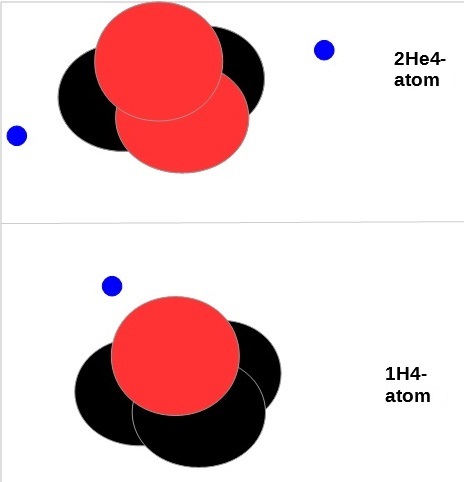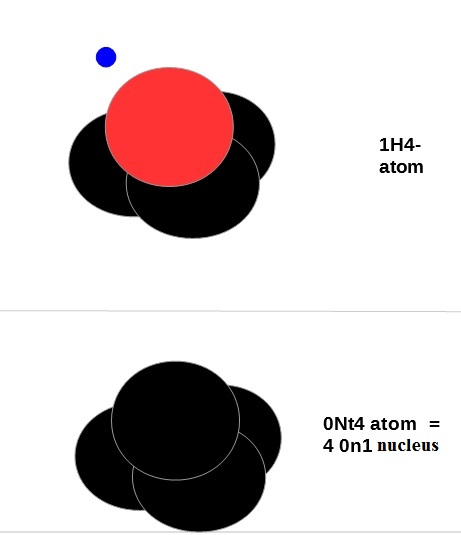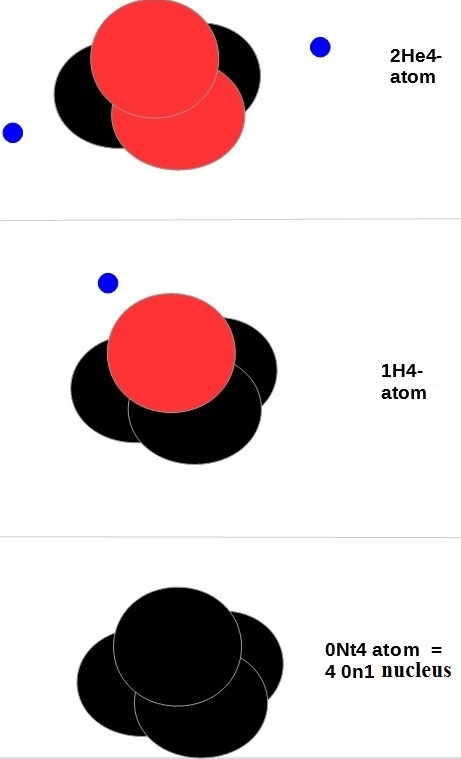'Superfluid helium' is no helium
The λ-transition
Liquid helium exhibits normal classical behavior between
the normal boiling point at 4·21 K and 2·17 K.
Below the latter temperature, indicated as Tλ, all properties changed drastically.
The most notable changes are those of the viscosity and thermal conductivity,
spontaneous siphon and the possibility to pass the most small leaks, the super leaks.
The usual way of describing the liquid was Tisza's two-fluid model.
For the record: Tisza's two-fluid model
If helium is directly below the Tλ,
so when helium turns in superfluid helium
it is pure helium I. Helium I is the 'normal' component.
If the temperature drops gradually helium I converts into helium II.
The neutral ions of He II, the superfluid component,
have been Bose-Einstein condensed.
Helium I and II form a homogeneous mixture,
but it just seems like there are two fluids.
In 1970 J. Wilks gives a detailed description in
"An introduction to Liquid Helium",
the Oxford Library of Physical Science.
Why something else?
Right under the Tλ helium would almost entirely be helium I
the normal component of the mixture,
while immediately the liquid changed into a bewildering good heat conductor.
This is contrary.
Nor it is clear why helium can penetrate through super small leaks due to Bose-Einstein condensation.
Go up
The hydrogen-neutralium theory
Postulate: in the λ-transition (in the direction of
decreasing temperature) all existing helium-4 nuclei catch a K-electron.
The neutral helium-4 ion has been plopped into the still
unknown hydrogen isotope hydrogen-4.

So far K-capture has been known only as an occasional accident.
But with this postulate there is a genuine phase transition.
It is supposed that the hydrogen-4 is helium-I in the two-fluid model of Tisza.
Due to the extremely low temperature the neutral
H-4 ions hardly associate to H2 molecules.
Cooling of 2·17 to 0·00 K gives increasingly more neutralium
If the temperature from Tλ = 2·17 K, drops away
the neutral hydrogen ions 4 gradually show further plopping in
by K-electron capture. This creates an isotope of a not yet
recognized element:

neutralium and the isotope neutralium-4 has been involved.
What looks like a tetraneutron is a neutralium ion (nucleus).
This new element gets number zero in the list of elements: Z = 0.
The position of neutralium in the periodic table of elements
of Mendelejev in the column of the noble gases before helium.
This neutralium-4 is the helium II in the old two-fluid model.
For some years the existence of these neutralium ions have been known.
Go up
References
- NewScientist.com news service, Michael Brooks 19 March 2005.
See http://www.newscientistspace.com/article.ns?id=mg18524911.600
- Press release: 'Can a nucleus be made up of neutrons only?', Paris, April 25, 2002
IN2P7 contact: Geneviève Edelheit Tel: +331 4496 4760
e-mail: edelheit@admin.in2p7.fr
- CNRS press contact: Martine Hasler Tel: +331 4496 4635
e-mail: martine.hasler@cnrs-dir.fr
- J. Phys. G: Nucl. Part. Phys. 29 No 2 (February 2003)
L9-L14 PII: S0954-3899(03)56964-X
- Physics Department, University of Surrey, Guildford,
Surrey GU2 7XH, UK. Published 10 January 2003
The lower the temperature, the more you get neutralium-4 at
the expense of the hydrogen-4
At any temperature below Tλ = 2·17 K form the hydrogen-4 and neutralium-4
a homogeneous mixture. At absolute zero, the initial helium
completely has been converted into neutralium.
A neutral neutralium ion is a nucleus without shell electrons.
This new element has number zero in the list of elements: Z = 0.
In Mendeleev's periodic table of elements you find neutralium
in the column of the noble gases before helium.
Go up
Compare
In the two fluid model of Tisza it seems, there are two fluids for real
while the individual neutral ions do not change.
in the hydrogen-neutralium-theory there are really two different
liquids between 0 and Tλ = 2·17 K, other than helium.
The atoms can be reversed into each other by plop in or plop out.
With increasing temperature, the plopping out prevailed.
Thermal conductivity
Almost could be said that superfluid helium is a
'thermal superconductor', because in a helium cryostat
temperature differences do not maintain permanently.
With metallic hydrogen it is easily understandable.
Indeed a metal is a good heat conductor.
Possibly super conductivity form heat exists.
Electrical conductivity??
Experimentally it is known that helium is an
electrical insulator under all circumstances.
Secondly, it is expected that metallic hydrogen
is an excellent conductor of electricity,
perhaps even a superconductor.
Possibly the metallic hydrogen is disturbed by the presence
of solid very near to that solid hydrogen plops out back to normal.
There is an insulating layer of liquid helium with a thickness
of "several thousand" neutral ions between
the metallic neutral ions hydrogen-4 and the solid.
The conductivity is thus masked by a surface effect.
Go up
Experimental verification
It is possible to investigate the electrical conduction
through 'helium' under Tλ, so through metallic hydrogen-4.
Because a normal electrical circuit is not feasible
due to the insulating layer of liquid helium
there is only one possibility to test the conductivity:
induce electrical eddy currents. This can have two effects:
heat dissipation and an accompanying magnetic field.
If the metallic hydrogen is a superconductor
no heat is dissipated. Since the concentration of
the metallic hydrogen at lower temperatures decreases, it is
expected that the electrical conductivity decreases therefore.
Nt-4 cannot provide conduction.
Challenge
We urge experimenters, whether they actually want to try to induce
eddy currents in superfluid "helium" and to try to detect the
induced magnetic field. Perhaps there is still some heat in sight.
Go up
Electrical superconductivity of metals
If the temperature of some metals was sufficiently low
there was superconductivity: the resistance was immeasurably low.
Some of these metals were in liquid helium.
Could the helium (basically the hydrogene-4) have been
the current conductor in some cases?
Super Leaks
Nuclei of neutralium are bosons. Therefore neutralium-4 can exhibit BEC.
But that does not just understandable how the "superfluid helium",
the smallest leaks, super leaks, can penetrate and pass.
Although hydrogen-4 in the vicinity of a solid plops out to helium-4,
Nt-4 does not plops out when it passes a hole in a solid.
A neutralium ion has no shell electrons and that is why
it is roughly hundred thousand times smaller than
a neutral hydrogen ion, which makes it clear that a nucleus
of neutralium can pass through each hole.
Energy
As generally an electron jumps from a higher energy level
to a lower one, the neutral ion emits a photon.
The theory cannot explain for sure why a photon is not
emitted when the electron is captured by the nucleus.
Possibly the energy is stored as vibrational energy in the nucleus.
The energy of the K-electron relative to the nucleus in the order of some MeV.
The graph that shows the specific heat of helium
at the temperature around Tλ shows the shape of the Greek letter λ,
hence the name λ-transition.
In my opinion this graph was always misinterpreted.
There is visible the net energy impact of the collective
plop in of helium-4 to hydrogen-4. Who does not know
the plop theory, cannot think about it of course.
From hot to cold
As the temperature goes down from very high to very low,
you see the trend to ever issue a further aggregation and partly
because of increasing order or, if you will, to reduce chaos.
If you start at extremely high temperatures and you cool down
you will see successively: the forming of trioes and nuclei,
the falling of electron particles into the nuclei,
allowing positive ions and neutral ones occur,
the association of (neutral) ions to molecules;
fumes condense to liquid solidification and
I add to this list to plop in. It fits neatly.

Other light elements
It is to be expected
He-3 can plop in to H-3 or tritium and on to trineutralium Nt-3,
deuterium to dineutralium Nt-2 and
H-1 to the discussed elpro
each with their own transition probabilities temperature dependent.
This can be investigated.


